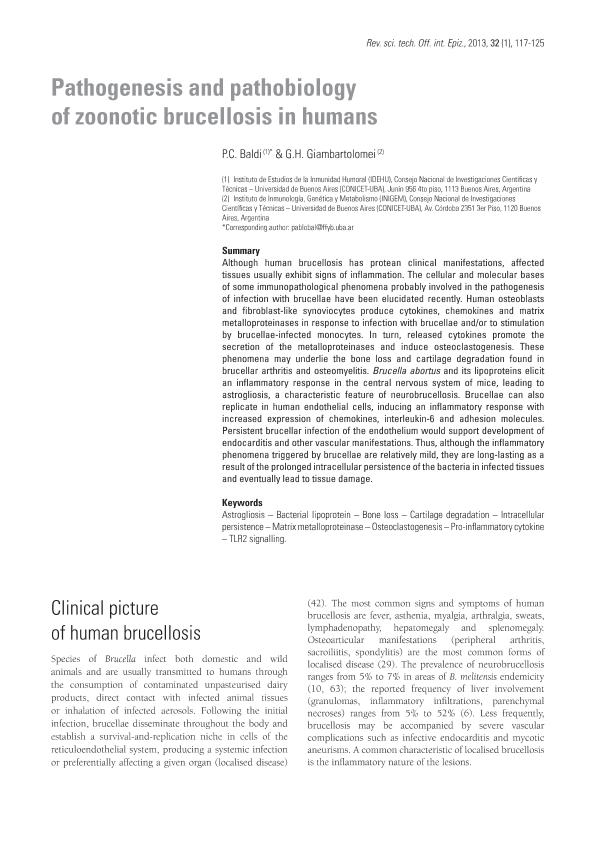Mostrar el registro sencillo del ítem
dc.contributor.author
Baldi, Pablo Cesar

dc.contributor.author
Giambartolomei, Guillermo Hernan

dc.date.available
2020-03-17T16:37:13Z
dc.date.issued
2013-06
dc.identifier.citation
Baldi, Pablo Cesar; Giambartolomei, Guillermo Hernan; Pathogenesis and pathobiology of zoonotic brucellosis in humans; Office Int Epizooties; Revue Scientifique Et Technique de L'office International Des Epizooties; 32; 1; 6-2013; 117-125
dc.identifier.issn
0253-1933
dc.identifier.uri
http://hdl.handle.net/11336/99839
dc.description.abstract
Although human brucellosis has protean clinical manifestations, affected tissues usually exhibit signs of inflammation. The cellular and molecular bases of some immunopathological phenomena probably involved in the pathogenesis of infection with brucellae have been elucidated recently. Human osteoblasts and fibroblast-like synoviocytes produce cytokines, chemokines and matrix metalloproteinases in response to infection with brucellae and/or to stimulation by brucellae-infected monocytes. In turn, released cytokines promote the secretion of the metalloproteinases and induce osteoclastogenesis. These phenomena may underlie the bone loss and cartilage degradation found in brucellar arthritis and osteomyelitis. Brucella abortus and its lipoproteins elicit an inflammatory response in the central nervous system of mice, leading to astrogliosis, a characteristic feature of neurobrucellosis. Brucellae can also replicate in human endothelial cells, inducing an inflammatory response with increased expression of chemokines, interleukin-6 and adhesion molecules. Persistent brucellar infection of the endothelium would support development of endocarditis and other vascular manifestations. Thus, although the inflammatory phenomena triggered by brucellae are relatively mild, they are long-lasting as a result of the prolonged intracellular persistence of the bacteria in infected tissues and eventually lead to tissue damage.
dc.format
application/pdf
dc.language.iso
eng
dc.publisher
Office Int Epizooties

dc.rights
info:eu-repo/semantics/openAccess
dc.rights.uri
https://creativecommons.org/licenses/by-nc-sa/2.5/ar/
dc.subject
Brucella
dc.subject.classification
Inmunología

dc.subject.classification
Medicina Básica

dc.subject.classification
CIENCIAS MÉDICAS Y DE LA SALUD

dc.title
Pathogenesis and pathobiology of zoonotic brucellosis in humans
dc.type
info:eu-repo/semantics/article
dc.type
info:ar-repo/semantics/artículo
dc.type
info:eu-repo/semantics/publishedVersion
dc.date.updated
2019-09-27T21:03:18Z
dc.journal.volume
32
dc.journal.number
1
dc.journal.pagination
117-125
dc.journal.pais
Francia

dc.description.fil
Fil: Baldi, Pablo Cesar. Consejo Nacional de Investigaciones Científicas y Técnicas. Oficina de Coordinación Administrativa Houssay. Instituto de Estudios de la Inmunidad Humoral Prof. Ricardo A. Margni. Universidad de Buenos Aires. Facultad de Farmacia y Bioquímica. Instituto de Estudios de la Inmunidad Humoral Prof. Ricardo A. Margni; Argentina
dc.description.fil
Fil: Giambartolomei, Guillermo Hernan. Consejo Nacional de Investigaciones Científicas y Técnicas. Oficina de Coordinación Administrativa Houssay. Instituto de Inmunología, Genética y Metabolismo. Universidad de Buenos Aires. Facultad de Medicina. Instituto de Inmunología, Genética y Metabolismo; Argentina
dc.journal.title
Revue Scientifique Et Technique de L'office International Des Epizooties

Archivos asociados
